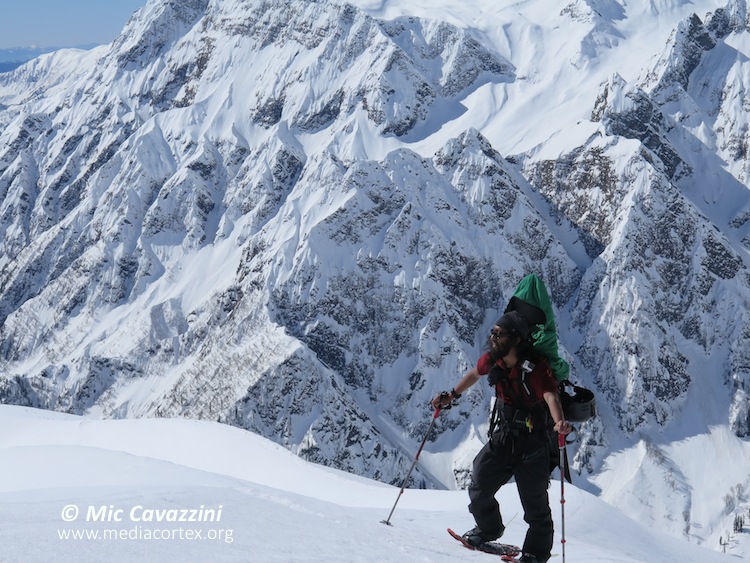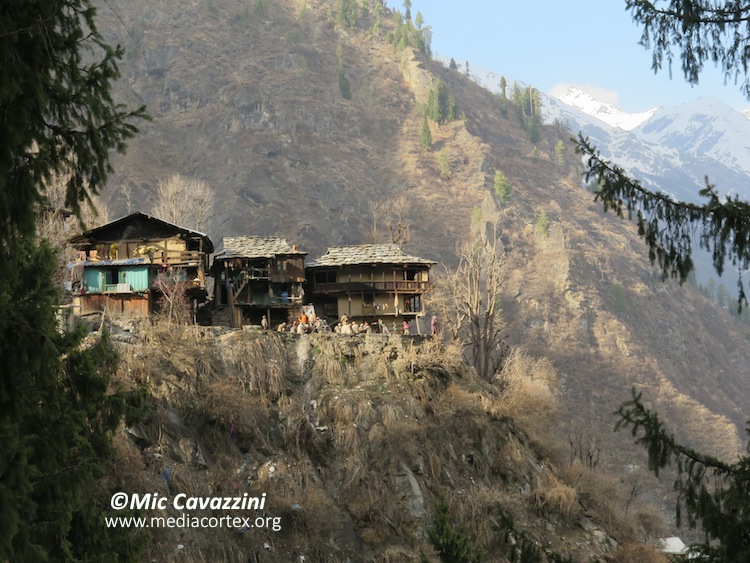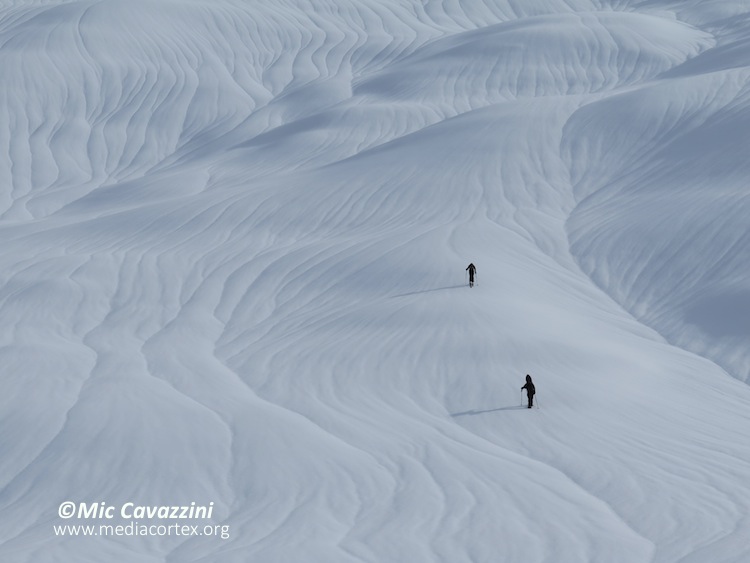HIMACHAL PRADESH
We move from Srinagar and Jammu down to Manali, a wearing trip as the highway has been covered by landslides in the spring rain and melt. Up the valley a little is the cute village of Vashisht, which as far as backpacker cred goes is the new Old Manali which was the old New Manali. I later get irked by wiry old travelers telling me “You should have been here in the seventies” but for the moment the combination of comfort and culture is perfect. Set on a steep green terraced hillside with blazing white peaks so close you can reach out touch them. More and more blossoms burst pink and white every day from the apple and almond trees. Dark wooden farm-houses with ornate windows and doors. Large slate roof tiles to match the narrow steps and walkways that wend their way through the village. Often you have to give way to cows that seem to get a lot of the best real estate. And naturally steaming spring water jets out into a couple washing pools, and a bathing temple.

We get smiles from the local shopkeepers and chew the fat with our scarved and grinning landlady. Every morning her dapper husband shuffles past each floor of the otherwise empty hotel with a bell, and when he sees us chimes “Om Shanti” in a gentle voice. If we look ridiculous to the villagers tramping through the cowshit in ski boots they are polite enough not to mention it. We ski up onto two of the 4200 metre summits, exhausting in the thin air, and on each missions spend a golden evening drinking in the stillness of the jagged alpine terrain from the door of our snow cave.

A few hours away up the Parvati valley is the mind-altering village of Malana. We go to visit because it’s said that it has a unique culture born of mountainous isolation. The caste system there is so extreme that anyone from an outside village is considered unclean… an “untouchable”. Despite its fairytale setting perched overlooking a deep gorge, the moment we arrive there are children playing marbles who shout “No touch- no touch!” Since they giggle at our reaction we assume they are making fun of us, but soon the women in the congested alleyways squeeze out of our way- “No touching!” These people are seriously alarmed, and when I make the mistake of stepping up on a stone platform to find a seat things really kick off.

It turns out this is part of a temple altar and a group of men start shouting angrily “You touch!! You pay!” It is then that I noticed a sign warning of fine for touching sacred buildings. The three men cluster around me wild-eyed and fuming. “Two thousands rupee. You pay” I protest my innocence- I didn’t see, I really only took the first step. “Yes you touch! No sorry. MONEY!!” At this point I wonder how much this is about genuine offence rather than the fleecing the foreigner and I quietly back out of the scene. Some time later a leathery French backpacker explains that yes it’s possible that a goat will need to be sacrificed to purify the building and that the fine offsets the cost of the animal.
I’m not sure what to think, because apart from those shouting at us in fear every other person in touch looks at us with beady eyes and says, “You want charas? You want chillum?!” See, this village is also famous for its Malana Cream- a batch of hashish made over the two week peak of the growing season. It is said only the palms of the women are soft enough to collect the finest of the resin, and then it is rolled by hand into the purest and softest hash imagineable. Stoners have been trickling in here since the seventies but now it is a drawcard for party-hunting Israeli backpackers, and the locals know the laws of supply and demand. One middle aged dealer follows us to spruik his wares- “look how soft!” as he stretches it like bubble gum and names an outrageous price three times the usual rate. At our protests he states “This not cream- this is Super Cream!” which makes us laugh out loud at the shameless marketing. God knows what else has been mixed in with it but maybe it’s all this smoking has made the locals so paranoid.
It feels like you’re not welcome in the village unless you’re there to buy drugs, and I’d love to explain to these people that some travelers are here for the culture not just to get high. Worse, it seems the men sit around waiting for clients while the women do all the hard word of tending the animals or hiking up the hillsides with wood or water. No surprise given that one or two sales equate to the average monthly income- but it’s a sad reflection of the impact that tourism has on the ‘natural balance.’ I guess none of us are ‘inert’ travelers, simply observing without creating any consequences for the economy and social order- but I wonder even more how responsible my own movements are.

I am captivated with the mental picture of arid windswept ‘Tibetan’ landscapes to the north, and decide to leave my friends for to chase that down. But the Rohtang pass is still piled with snow until June and flying into Ladakh seems like cheating. The Spiti valley is not far on paper but to get there I need to do a massive detour to enter via the Hindustan-Tibet “highway.” Right from the start I am thrown by a coach cancelation that turns the journey into an epic jigsaw of private taxi-local bus- walking 5km over a pass in the rain- shared taxi- local bus- stand in a desolate bus depot at nightfall to catch the last local bus east- find I’m stranded with no hotel unless I get an expensive private taxi 15km further on. This is merely a taste of the journeys to come.

Here my photographic journey ends, as all the wonderful pictures taken later were never backed up, and stolen much later along with my camera.
Along the way I pass a peculiar bare fort of wood and stone that is in fact a local style of Hindu temple built to handle earthquakes. Then the lovely fertile-looking fruit plantations give way to monstrous concrete bulwarks around 70m high, damming a steep dusty valley. Squeezed on the banks are grids of soviet looking rectangular apartment blocks that house employees of the hydro-electric projects or army personnel. This is hint at the scale of the resource war being fought all along the Indian-Chinese border. Another example crops up later in my journey, after a Chinese news program shows a map of India that is missing this province and that of the disputed Arunachal Pradesh in the east.
The scenery returns to rustic bliss in the region of Kinnaur and the people are equally captivating. Wiry looking men and handsome women with faces that could almost come from the Mediterranean. Both sexes wear charming cylindrical felt caps with a green lining turned up at the front. They seem a practical people, but quick to jest and say hello to a stranger. In a local bus I am squeezed intimately next to an old lady, and young guys too will lounge or stroll with arms draped around a mate’s shoulder. I like the fact that I don’t turn many heads here.
I watch another spellbinding alpine sunset from the cluttery wooden village of Kalpa before heading north in a shuddering metal lunchbox of a bus. Very soon I discover the dubious blessing of being the first tourist of the season to enter the snowbound valley. We leave the tree-line behind and the road clings desperately to steep slopes of crumbling sediment every shade from grey to brown. The layered cliffs look like toppled bookcases and they are in a constant state of decay. Sometimes the landslides are a fine scree that carpets the road. The jeep pulls up behind a goods truck whose men are shoveling and hurling rocks. One stands watch to alert them of the constant danger from above and when a window of opportunity appears he urgently waves his hand to say “Challe! Challe!” or “Let’s go”. I’m horrified to see the truck grind up to speed and tail slide on the gravel only a foot from the slippery edge. Further along blocks of stone the size of fridges and billiard tables stand like sentries- while at other points the road itself has dissolved away. The only way to keep it open is to dig deeper and deeper into the cliff- so that it starts to resemble half a tunnel dug by a child in a sandpit. The bus lurches like a metronome into the cliff wall while stones ping off the roof, and something makes me think of the Neverending Story and the epic challenges the characters face on their odyssey.
I’m dropped off at nightfall at a dusty intersection at the top of countless zigs and zags. The twighlight radiates from the nearby snowline but there is no other sound or light save the gasp of a pale LED at a corner store. I start to wonder what the hell I’m doing and ask for help at the corner store. The guy shakes his head but eventually I’m shown to an unfinished block of steel and concrete surrounded by snow with some musty rooms and piles of blankets. “Water pipe frozen. You toilet outside. No food. Dhaba near bus stand. 300 Rupees. OK OK 200 OK.” The man disappears into the night without me ever seeing his face in my two days there. The dhaba eatery turns out to be the social hub of town- inasmuch as the handful of blokes not at home by 8pm are found here drinking chai or bad Indian whisky. In the eery LED light and beedie smoke I glimpse weathered faces, but they are nonplussed to see me. Except for the question “Why you come here in winter?” from the chain-smoking owner with an Errol Flynn moustache. He becomes my lifeline for a couple of days given his smattering of English and the fact I depend on his $1.50 his daal, rice and vegetable subzie.
The next day I ignore his advice and attempt the snowcovered trail to the Tashigang monastery or ghompa- after three hours of stunted progress over a windswept pass draped in fluttering prayer flags I am forced to turn around. But further up the valley are the farm town and ghompa of Tabo- at 1200 years old it is the oldest Buddhist centre in India in continuous use. Very simple rounded mud-brick chapels bely the wondrous paintings inside. Frescoes in radiant colour and detail show the life of Buddha and other protector spirits and elaborate scenes of rural life. I have no idea how they have survived the centuries in such a state, but I happily donate some money to my guide, a beaming statuesque monk with the unforgettable name of Topten.
The next few days tick all the boxes of my delusions to National Geographic-style exploration. A stark arid valley of dirt and snow. Tiny whitewashed houses with ornate doorways and totems on the rooves. Gorgeous children with Tibetan faces who shout “Ju-lei!” to say hello. Yaks. Noble looking yaks who pull ploughs in the fertile fields at the floor of the valley. As spring melts the snow the locals are just starting to prepare the soil for the pea plantation- a surprisingly valuable crop that means there is some wealth in the area despite its remoteness. And perched atop the ragged cliff lines are breathtaking monasteries- seemingly placed there by a supernatural hand, their location seems so unlikely.
In my homestays in Dhankar and Kaza I have very informative conversations with well-spoken young guys. Because of the agriculture and tourism they’ve had the fortune of traveling to bigger towns outside the region for their education. I am pleased by this unlikeliness of such opportunity in an apparently barren landscape. It seems that development here is well-managed and that no one is going hungry. An NGO has been helping them build an eco-friendly sewage system. But in one of the homes the face of a dark scrawny Bihari kid stands out like chalk and cheese. The shy fifteen year-old boy with wide doe eyes is thousands of miles from his home in the poorest province in India… and somehow he has ended up here to work as kitchen boy in a simple guest house.
I can only imagine the loneliness, but he is only one of many unexpected economic migrants I meet along the way. Another is a Kashmiri carpenter who seems as tough and weathered as the wood he works. He comes out every year to work the summer in Spiti. And then there is the peasant girl around my age who speaks incredible English. “I went to an mission school in Arunachal Pradesh” on the other side of the country towards Burma. She proves very helpful and I am glad she’d received such an education, but wince a little when she tells me “I have also accepted Christ.” India is such a bewildering and mix of cultures, and the social change is so fast, I’m unable to make sense of the overall moral dynamics going on.
***
March-April 2015

